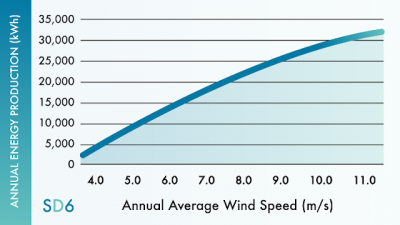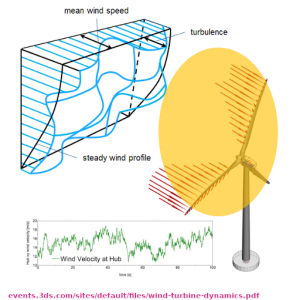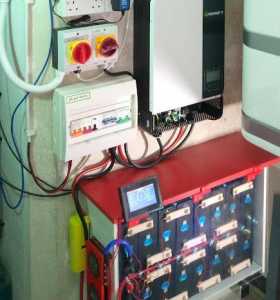@derek-m I've seen this before - indeed I've seen a lot of new potential wind technology videos on YouTube. However, none of them seem to have reached commercialisation stage yet, and that means going with the tried and trusted for now. The SD6 seems like a good solution for us and where we live.
Correct. The G98/G99 approvals system is solely for generation devices that can export to the Distribution Grid.
It is not required for off-grid battery storage. You can have as much of that as you want. Nor is it mandatory to use an MCS-accredited company to install it because you'll not be applying for the meagre amount of money on offer for feeding back to the grid.
I wrote a Tutorial about this over on the OVO Forum almost 2 years ago. It's on my ToDo list to have a re-write and get the information published here too.
I am in direct contact with DNO Network engineers about this stuff, so feel free to ask for further clarification if you need it.
Save energy... recycle electrons!
@transparent Very useful thank you. Do you recommend any particular off grid battery storage systems?
Posted by: @knukes@derek-m I've seen this before - indeed I've seen a lot of new potential wind technology videos on YouTube. However, none of them seem to have reached commercialisation stage yet, and that means going with the tried and trusted for now. The SD6 seems like a good solution for us and where we live.
Considering the overloading possibility highlighted by Transparent, have you considered a smaller model?
Transparent, if the SD6 can 'feather' its blades, what power turn down can it achieve?
The SD6 makes sense as we use a lot of electricity. Our bill in October was around £350.
Posted by: @derek-mConsidering the overloading possibility highlighted by Transparent, have you considered a smaller model?
Unlike PV solar panels, the typical day's output from a wind turbine is very much below its maximum rating. If you'd like to get a daily average of 1000kWh over the course of the year, then you need to select a turbine with a peak output 5x that (a 5kW generator).
Each turbine has its blade pitch and loading profile (in software) set at the time of commissioning. Depending on the range of wind-speeds anticipated in that location, it's usually the case that you will get zero power output until the mean velocity reaches 5m/s. You can lower this figure, but doing so compromises the potential maximum that the turbine can achieve. It effectively reduces the slope of the output curve.
Wind velocity profiles are very complex to visualise, even if you start by ignoring its direction. Have a look at this attempt from a presentation by Dessault Systemes
Before I erected my own turbine tower, I took 8 months of measurements using a small anemometer on top of a redundant electricity pole. You obviously need a pole-mount type; Have a look on ebay or here on Amazon.
I would expect SD Wind's appointed installers to have software tools which enable them to do a desktop study on an area to within a 3km square.
Posted by: @derek-mTransparent, if the SD6 can 'feather' its blades, what power turn down can it achieve?
It's a passive spring-system. There's no reduction in power. In strong winds it will simply retain the specified 6kW output.
If you want a turbine with programable/motorised variable pitch, then you need to be spending around £50k.
Save energy... recycle electrons!
Posted by: @knukesDo you recommend any particular off grid battery storage systems?
These don't really exist as an off-the-shelf system.
There are a number of items which you would assemble to achieve the desired result. The assembly of such off-grid storage owes a great deal to the crofters and out-backers who have pioneered the way over the decades.
Due to those origins, the DIY approach has prevailed. We've been discussing many of the component parts and the concepts over on the topic Anyone want to share costs on batteries?
You can read there of a couple of Forum Members who are buying 280Ah LiFePO4 (Lithium Ferrous Phosphate) cells and a Mason box from Seplos in which to house them. That comes with an integral Battery Management System (BMS).
You can see here one of my own in-house assemblies.
The battery consists of 16 cells in series, positioned in an enclosure not very dissimilar to a kitchen cupboard! That's a 14kWh battery, for which you'd pay around £2500.
In my case, there is a separate red box to the left, which is a 200A (max) BMS unit from China. Next to it is a yellow box with a 250A safety fuse. Above and to the right is a Growatt hybrid off-grid inverter. That can receive power from either/both the 240v AC grid and an array of PV solar panels.
The bit I'm less certain about is what sort of charger/inverter would be required for a wind-turbine. This depends on what 'electronics box' comes with the SD Wind 6kW turbine. If it offers a steady DC voltage output then that's a good start.
I would expect you'll need a separate battery-charger and inverter, rather than the Growatt model in my picture which does both tasks.
You can use a local installer/electrician to assemble such a configuration. They don't need to be MCS accredited.
Overall costs would end up around 70% of the price of a grid-connected storage battery, including labour.
Save energy... recycle electrons!
@transparent Yes, the desktop survey suggested approximately 5.9m/s average wind speed, so we’d anticipate getting just below 15,000kwh production per year typically.
@knukes - I think this is a subject which will become clearer as you talk with others. It's a typical pub discussion!
I've had a look to see if any of the Transition Towns groups in your area state that they are involved in micro-generation. But alas, their main projects seem to related to horticulture.
I'd be very surprised if there weren't others near you who are investing in off-grid battery storage. They may even be professional electrical contractors. The tricky bit is how to find them.
One possibility is for you to contact Fogstar. They are a UK company who supply the LiFePO4 cells and a few other essential components (BMS etc). Ask them if they've recently sold products to anyone in Greater Manchester, and if they'd mind emailing those customers to find out if they'd be willing to show you what they're up to. They may even have an associated customer support group online.
You should also look online to find technical expertise in wind turbine storage which comes from the Scottish island of Scoraig.
Led by Hugh Piggott, that community has been hand-building their own wooden wind turbines for a couple of decades. People would travel from all over the world to spend a week or two with Hugh, learning the necessary skills.
It is highly likely that they have now moved on to use lithium cells for storage, but I don't know who in Scoraig would be able to tell you of this.
May I also point out that I have a commercial interest in this subject.
Over the past 18-months I've migrated from running my house lighting (off-grid) using lead-acid batteries and instead operating with lithium-based cells.
Consequently I've become aware of design-flaws in some component parts, generally devices imported from the Far East. I have also noticed a lack of storage-controllers which are able to function to our advantage within the UK's energy distribution system.
I am now in partnership with others to design software-based devices which can detect when electricity is available
- from renewable sources
- generated locally
- at lower price points
- beyond the capacity of the National Grid (a common situation in SW Region where I'm based)
There are currently no domestic tariffs which could take advantage of the devices we are developing. But there will need to be if the UK is to meet its Nett Zero target of 2050. So we are designing products now which could be required in future.
It is coincidental that I have previous experience of domestic wind-turbines. At some point I'll find enough time to build a new PMG and head-stock for my aluminium turbine tower. But let's solve the energy crisis first 🙂
Save energy... recycle electrons!
@transparent Many thanks for your tips. It is very much appreciated.
In terms of your software solutions, will it be used with specific hardware?
Posted by: @knukesIn terms of your software solutions, will it be used with specific hardware?
That question needs dividing into two parts for me to answer it:
1: Our software will end up running on a dedicated micro-controller platform. If you've come across devices like the Arduino and ESP32 then you'll know what such embedded computers look like.
Imagine a grey box with some connection ports to:
- internet (home WiFi?) through which data arrives regarding weather and energy-mix forecasts for your area
- Smart Meter
- the BMS which looks after your storage battery
- the charger (solar and/or mains grid and/or wind-turbine etc)
- the inverter which creates the 240v AC for off-grid use
No decision has been taken as to which micro-controller platform will be used. And it doesn't matter to the end-user either. I doubt that many consumers bother to enquire which processor is used by their TV set!
2: There will be a range of hardware devices which can be in communication with the embedded controller.
Initially I thought this would be extensive, with over a dozen different BMS units, for example.
However, tests during the past year have shown that a very high proportion of such units from the Far East don't even fulfill their advertised functional specification, let alone obey commands sent from an external controller!
I am stunned that the renewable energy market has a proliferation of electrical devices which do not (and cannot) operate as described. Most are purchased and installed without the end-user having either the equipment (multimeter) or knowledge to check whether they are working correctly.
As such, I suspect the list of 3rd-party 'devices' which can be supported is far shorter than any of us would like!
I wouldn't be too concerned at this uncertainty. A BMS unit accounts for less than 5% of the value of the battery it is protecting. Changing it for a different model at a later date has no affect on the original investment in the lithium cells themselves.
There are many more inverters of sufficient capacity to operate an ASHP. They might cost around £1000+, so you don't really want to change that for a different model once UK Energy Suppliers start advertising locationally-based Time of Use (ToU) tariffs. (Remember, we can't release a product without a tariff that it can operate with!)
So it's possible that you might buy an inverter (or a charger) now which we later discover can't talk to one our smart controllers.
That's not so critical as it might seem at first.
If we're unable to ask the inverter/charger what current/voltage it's passing through, then it's not that difficult to add a separate energy-meter into the circuit.
Or if we need to remotely turn a charger on/off, and there isn't a software command to do so, then the controller could still use a relay to have the same effect.
But you're still a way off from buying an inverter or charger.
At the moment you're still probably coming to terms with the underlying concepts of storing electricity to drive a heat-pump.
You need to hear from others, not just me. Have you yet seen what @batalto wrote here of his experience in building his very first off-grid battery box just a month ago?
Save energy... recycle electrons!
- 26 Forums
- 2,396 Topics
- 54.3 K Posts
- 318 Online
- 6,077 Members
Join Us!
Worth Watching
Latest Posts
-
RE: Considering MLCP (Multi-Layer Composite Pipe) for ASHP
OK, TBH I dont know enough about MLCP to comment with a...
By JamesPa , 2 minutes ago
-
RE: Predicted Heat Loss from MCS calcs vs EPC vs actual
My gut feeling is that the heat pump is right sized. ...
By Tim441 , 23 minutes ago
-
RE: Heat pump not reaching flow temperature
Peak Energy Products most recent accounts (to June 2024...
By JamesPa , 50 minutes ago
-

RE: Power outages and storms: A surprisingly good DNO experience
Agreed, which is no more nor less than a customer shoul...
By Majordennisbloodnok , 2 hours ago
-

RE: Running from backup generaor in powercut?
@batpred In our case, 3 times each day when the Octopus...
By Toodles , 2 hours ago
-
RE: Advice for a novice on Mitsubishi Ecodan 6kW
Hi @sheriff-fatman Cycling at 5C and below is usuall...
By RobS , 3 hours ago
-
RE: Recommended home battery inverters + regulatory matters - help requested
The diagram describes what happens inside the Solis. Al...
By Batpred , 4 hours ago
-
RE: New Fogstar 15.5kWh upright solution
@batpred Here's the latest Fogstar ready built pack....
By Bash , 4 hours ago
-
RE: RDSAP10 effect on existing heat pump EPC rating?
@mike-patrick yes, even though the current system is ru...
By Tim441 , 4 hours ago
-
RE: Solis inverters S6-EH1P: pros and cons and battery options
Solis confirmed that the S6 works with a single battery...
By Batpred , 5 hours ago
-
RE: Who has a V2G EV installation
I am wondering if in any V2X, would the car battery eve...
By Batpred , 6 hours ago
-

RE: Setback savings - fact or fiction?
Yes, by calculating it manually from the minute data, w...
By cathodeRay , 7 hours ago
-
Fan unit Making terrible noise HELP!!
One of a pair of fan units on an Earth Save Classic II ...
By GutoFfowc , 7 hours ago
-
RE: New Mitsubishi Ecodan 11.2kW installation - L9 errors and maybe more
OK. I think your system, which seems well designed, is...
By JamesPa , 9 hours ago
-

RE: Heatpunk Floor plan issues
It's usually the complete opposite... seldom that Safar...
By Mars , 22 hours ago
-

RE: Fan is clipping ice build up from the front of unit.
@majordennisbloodnok I’ll not go there thanks! Toodles.
By Toodles , 1 day ago
-
RE: Running my new Nibe ASHP efficiently
I'm new to the forum. Did you get a reply to this last ...
By Mike @ Camelot , 1 day ago
-

RE: ASHP Energy Consumption: Aira 12kW heat pump
@grantmethestrength MCS requirements for DHW capacity h...
By Toodles , 1 day ago
-
RE: Help me keep the faith with my air source heat pump installation
@adamk I'm observing my own system at low temperatures ...
By dr_dongle , 1 day ago









